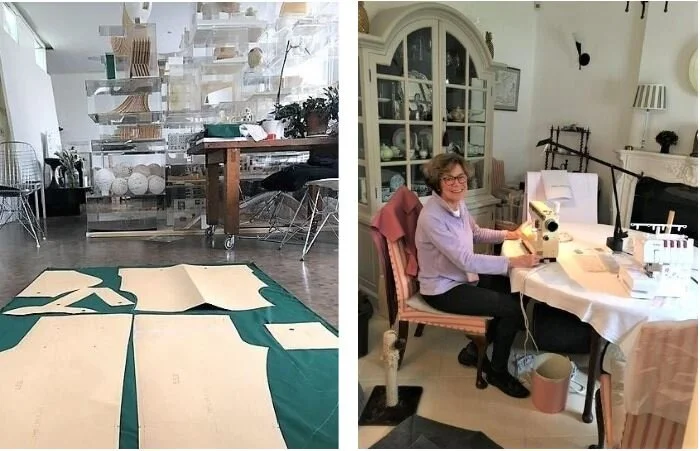ARCHITECTS ON THE FRONTLINE / Fabrication via Scrub-Hubs
This article has been written as part of the AIA Newsletter’s commitment to member news. If you are aware of UK Chapter members’ involvement in newsworthy projects, research or events, please bring them to our attention via chapterexecutive@aiauk.org and we will publish the story. Remember we will not know what has been achieved unless someone tells us!
Fabrication is ‘the action or process of manufacturing or inventing something’. Of course, fabrication does not have to involve real fabric, but – when it does – it can doubly fulfill an architect’s potential. It turns out a sewing project can be as complex as any design-build one.
Deborah Bartlett, Int’l Assoc AIA RIBA - architect and (sometimes) seamstress – has also been an AIA UK Chapter Board Director for the past several years. Below is a personal story of how she put her architectural and organizational skills to use during the coronavirus crisis:
‘I have been using a sewing machine since the age of three. My mother had resisted my pleading and wheedling for several weeks (my sister and I were at home, in quarantine, after my sister’s closest school-friend had contracted and died from poliomyelitis), but finally relented and - warning me to keep my fingers away from the presser foot and needle of her hand-cranked Singer - talked me through the workings of the machine. And I was off! Making endless, scrappy clothes for my teddy bear and doll.
And ever since then, using a succession of ever more versatile machines - I have been making dresses and jackets, skirts and trousers, shirts and suits, curtains and cushion covers, soft toys, theatrical costumes, and even – once - a wedding dress.
So one morning in March when a Royal London Hospital doctor in an interview on Radio Four’s Today programme highlighted not only the critical lack of PPE in general, but also the huge surge in the need for medical scrubs given their increased use by ALL hospital staff rather than just the usual cohorts, I understood that I just might be able to do something - very small - to help.
I could make scrubs…
Working from home. Pattern cutting chez architect Gianni Botsford. Setting up shop chez Deborah Bartlett.
Getting started was not straightforward; what pattern should be followed? what fabric should be used? what colours are approved? how could completed scrubs be delivered? and to which hospitals?
Meanwhile, a group of young women based in Hackney Wick, east London, and working in the clothing and fashion industry, got together to establish first one and then a network of scrub-making hubs - voluntary community groups of people who love to sew and would make scrubs to help meet the sudden and massive increase in need. Read more about scrub-hubs HERE.
They established a website; secured NHS approval to a pattern for each scrub-hub to follow; and developed guidance notes on making up the garments. Guidance notes were also developed for setting-up a hub and for raising funding for fabric, thread, elastic, tape and interlining, which needed to be procured by each hub independently.
I downloaded the pattern and forwarded it to Timothy Hatton Architects (Tim and I have been friends since high-school days) who kindly used their plotter to print it out at full scale and then had it delivered to me by courier. I had ordered the materials and was ‘all set’!
In due course, I became part of a small scrub-hub that was established near my house in west London and, for four weeks, spent my days - but not the weekends - making scrubs in dark green, crushed-raspberry-pink, and navy blue.
Medical scrubs look like the simplest, most basic garments imaginable. But as with all thought-through designs there is more to them than meets the eye. The V-necks are faced with a softly stiffened facing; tops and trousers have patch-pockets; tops have side-vents; and trousers have waistbands that are partly elasticated and partly drawcord-adjustable. Making more than three sets each week - for an amateur working alone, at home – was challenging.
For the time being, our scrub-hub’s activity is paused: the NHS trusts we have been supplying now have adequate stocks. Things could change, but the volunteers are ready to go into action again if and when the need arises.’
Anahi Copponex (Gianni Botsford’s wife) hard at work.
Written by Deborah Bartlett, Int’l Assoc AIA





